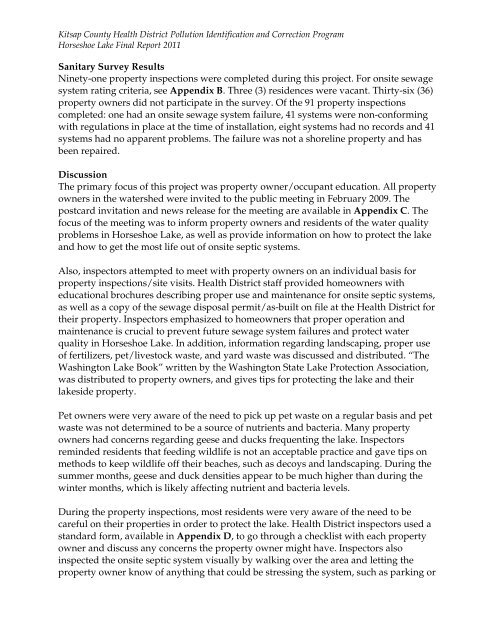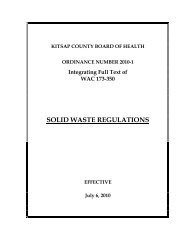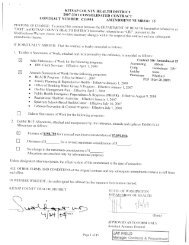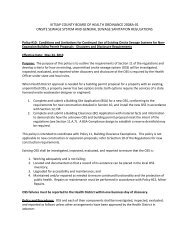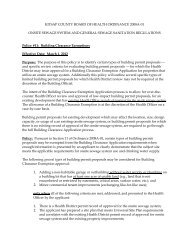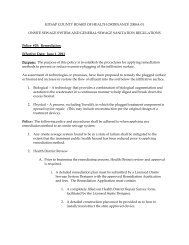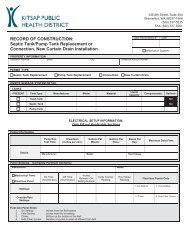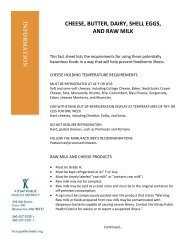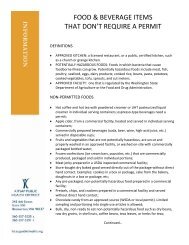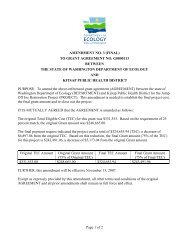Horseshoe Lake Water Quality Improvement Project, 2011
Horseshoe Lake Water Quality Improvement Project, 2011
Horseshoe Lake Water Quality Improvement Project, 2011
You also want an ePaper? Increase the reach of your titles
YUMPU automatically turns print PDFs into web optimized ePapers that Google loves.
Kitsap County Health District Pollution Identification and Correction Program<br />
<strong>Horseshoe</strong> <strong>Lake</strong> Final Report <strong>2011</strong><br />
Sanitary Survey Results<br />
Ninety-one property inspections were completed during this project. For onsite sewage<br />
system rating criteria, see Appendix B. Three (3) residences were vacant. Thirty-six (36)<br />
property owners did not participate in the survey. Of the 91 property inspections<br />
completed: one had an onsite sewage system failure, 41 systems were non-conforming<br />
with regulations in place at the time of installation, eight systems had no records and 41<br />
systems had no apparent problems. The failure was not a shoreline property and has<br />
been repaired.<br />
Discussion<br />
The primary focus of this project was property owner/occupant education. All property<br />
owners in the watershed were invited to the public meeting in February 2009. The<br />
postcard invitation and news release for the meeting are available in Appendix C. The<br />
focus of the meeting was to inform property owners and residents of the water quality<br />
problems in <strong>Horseshoe</strong> <strong>Lake</strong>, as well as provide information on how to protect the lake<br />
and how to get the most life out of onsite septic systems.<br />
Also, inspectors attempted to meet with property owners on an individual basis for<br />
property inspections/site visits. Health District staff provided homeowners with<br />
educational brochures describing proper use and maintenance for onsite septic systems,<br />
as well as a copy of the sewage disposal permit/as-built on file at the Health District for<br />
their property. Inspectors emphasized to homeowners that proper operation and<br />
maintenance is crucial to prevent future sewage system failures and protect water<br />
quality in <strong>Horseshoe</strong> <strong>Lake</strong>. In addition, information regarding landscaping, proper use<br />
of fertilizers, pet/livestock waste, and yard waste was discussed and distributed. “The<br />
Washington <strong>Lake</strong> Book” written by the Washington State <strong>Lake</strong> Protection Association,<br />
was distributed to property owners, and gives tips for protecting the lake and their<br />
lakeside property.<br />
Pet owners were very aware of the need to pick up pet waste on a regular basis and pet<br />
waste was not determined to be a source of nutrients and bacteria. Many property<br />
owners had concerns regarding geese and ducks frequenting the lake. Inspectors<br />
reminded residents that feeding wildlife is not an acceptable practice and gave tips on<br />
methods to keep wildlife off their beaches, such as decoys and landscaping. During the<br />
summer months, geese and duck densities appear to be much higher than during the<br />
winter months, which is likely affecting nutrient and bacteria levels.<br />
During the property inspections, most residents were very aware of the need to be<br />
careful on their properties in order to protect the lake. Health District inspectors used a<br />
standard form, available in Appendix D, to go through a checklist with each property<br />
owner and discuss any concerns the property owner might have. Inspectors also<br />
inspected the onsite septic system visually by walking over the area and letting the<br />
property owner know of anything that could be stressing the system, such as parking or


